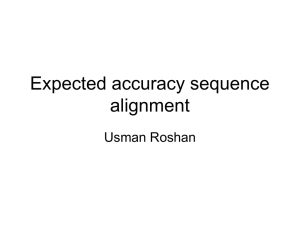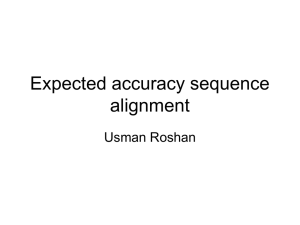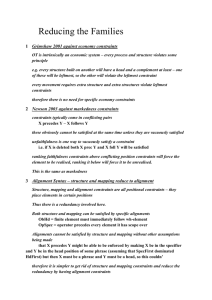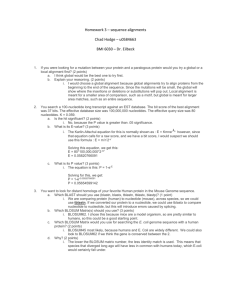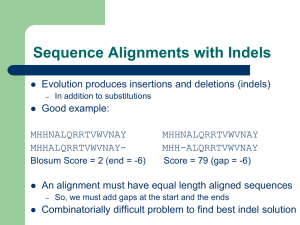Supplementary Material - Department of Computer Science • NJIT
advertisement
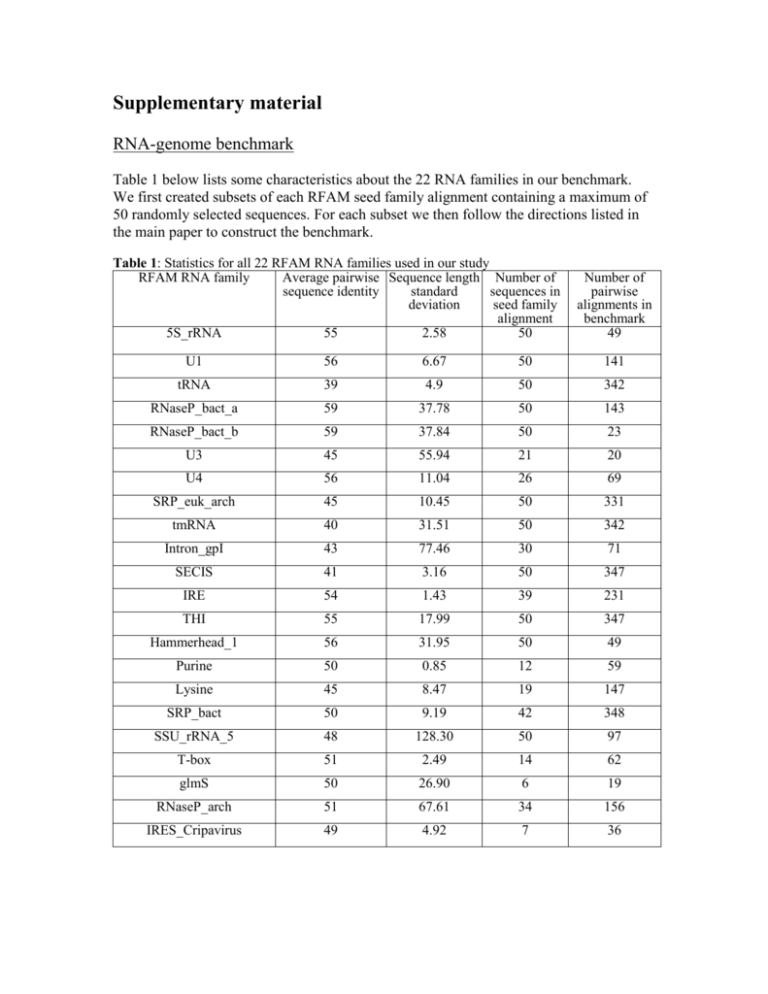
Supplementary material
RNA-genome benchmark
Table 1 below lists some characteristics about the 22 RNA families in our benchmark.
We first created subsets of each RFAM seed family alignment containing a maximum of
50 randomly selected sequences. For each subset we then follow the directions listed in
the main paper to construct the benchmark.
Table 1: Statistics for all 22 RFAM RNA families used in our study
RFAM RNA family
Average pairwise Sequence length Number of
sequence identity
standard
sequences in
deviation
seed family
alignment
5S_rRNA
55
2.58
50
Number of
pairwise
alignments in
benchmark
49
U1
56
6.67
50
141
tRNA
39
4.9
50
342
RNaseP_bact_a
59
37.78
50
143
RNaseP_bact_b
59
37.84
50
23
U3
45
55.94
21
20
U4
56
11.04
26
69
SRP_euk_arch
45
10.45
50
331
tmRNA
40
31.51
50
342
Intron_gpI
43
77.46
30
71
SECIS
41
3.16
50
347
IRE
54
1.43
39
231
THI
55
17.99
50
347
Hammerhead_1
56
31.95
50
49
Purine
50
0.85
12
59
Lysine
45
8.47
19
147
SRP_bact
50
9.19
42
348
SSU_rRNA_5
48
128.30
50
97
T-box
51
2.49
14
62
glmS
50
26.90
6
19
RNaseP_arch
51
67.61
34
156
IRES_Cripavirus
49
4.92
7
36
Program command line parameters
In the descriptions below <data> refers to unaligned query and genome sequence in
FASTA format and <query> and <genome> refer to the separate sequences also in
FASTA format.
Probalign:
probalign –nuc –T 7 –go 32 –ge 2 <data>
SSEARCH:
ssearch –H –q –d 1 –a -3 –f 10 –e 4 -O ssearch.out <query> <genome>
BLAST:
bl2seq –p blastn –G 8 –E 6 –W 4 –S 1 –r 5 –q -4 –i <query> -j <genome>
ClustalW:
clustalw –infile=<data> -outorder=input –output=fasta –outfile=cw.out
HMMER:
(1) hmmbuild –nucleic –informat=PHYLIP –f –F model.hmm <query>
(2) hmmsearch model.hmm <genome>
Probalign
We first explain the maximal expected accuracy alignment methodology and how match
or posterior probabilities are used. We then explain how to compute these probabilities
using partition function matrices and finally tie it with expected accuracy alignment in
the Probalign program.
Posterior probabilities and maximal expected accuracy alignment
Most alignment programs compute an optimal sum-of-pairs alignment or a maximum
probability alignment using the Viterbi algorithm (Durbin et al., 1998). An alternative
approach is to search for the maximum expected accuracy alignment (Durbin et al., 1998;
Do et al., 2005). The expected accuracy of an alignment is based upon the posterior
probabilities of aligning residues in two sequences.
Consider sequences x and y and let a* be their true alignment. Following the
description in (Do et al., 2005) the posterior probability of residue xi aligned to yj in a* is
defined as
P( xi ~ y j a*| x, y) P(a| x, y)1{xi ~ y j a}
aA
(1)
where A is the set of all alignments of x and y and 1(expr) is the indicator function which
returns 1 if the expression expr evaluates to true and 0 otherwise. P(a|x,y) represents the
probability (our belief) that alignment a is the true alignment a*. From hereon we
represent the posterior probability as P(xi ~ yj) with the understanding that it represents
the probability of xi aligned to yj in the true alignment a*.
Given the posterior probability matrix P(xi ~ yj), we can compute the maximal
expected accuracy alignment using the following recursion described in Durbin et al.,
1998.
A(i 1, j 1) P( x ~ y )
i
j
A(i, j) max
A(i 1, j)
A(i, j 1)
(2)
According to equation (1) as long as we have an ensemble of alignments A with their
probabilities P(a|,x,y) we can compute the posterior probability P(xi ~ yj) by summing up
the probabilities of alignments where xi is paired with yj . One way to generate an
ensemble of such alignments is to use the partition function methodology, which we now
describe.
Posterior probabilities by partition function
Amino acid scoring matrices, normally used for sequence alignment, are represented as
log-odds scoring matrices (as defined by Dayhoff et al., 1978). The commonly used sumof-pairs score of an alignment a (Durbin et. al., 1998) is defined as the sum of residueresidue pairs and residue-gap pairs under an affine penalty scheme.
S (a ) T
ln( M
( i , j ) a
ij
/ f i f j ) ( gap _ penalties)
(3)
Here T is a constant (depending upon the scoring matrix), Mij is the mutation probability
of residue i changing to j and fi and fj are background frequencies of residues i and j. In
fact, it can be shown that any scoring matrix corresponds to a log odds matrix (Karlin and
Alstchul 1990; Altschul 1993).
Miyazawa 1995 proposed that the probability of alignment a, P(a), of sequences x
and y can be defined as
P(a) e S (a )/ T
(4)
where S(a) is the score of the alignment under the given scoring matrix. In this setting
one can then treat the alignment score as negative energy and T as the thermodynamic
temperature, similar to what is done in statistical mechanics. Analogous to the statistical
mechanical framework, Miyazawa 1995 defined the partition function of alignments as
Z (T )
a A
e S (a )/ T
(5)
where A is the set of all alignments of x and y. With the partition function in hand, the
probability of an alignment a can now be defined as
P(a, T ) e S (a)/ T / Z (T )
(6)
As T approaches infinity all alignments are equally probable, whereas at small values of
T, only the nearly optimal alignments have the highest probabilities. Thus, the
temperature parameter T can be interpreted as a measure of deviation from the optimal
alignment.
The alignment partition function can be computed using recursions similar to the
Needleman-Wunsch dynamic algorithm. Let ZMij represent the partition function of all
alignments of x1..i and y1..j ending in xi paired with yj, and Sij(a) represent the score of
alignment a of x1..i and y1..j. According to equation (5)
M
i, j
Z
e
S ij ( a ) / T
a Aij
s( xi , y j ) / T
S i 1, i 1 ( a ) / T
e
e
a Ai 1 j 1
(7)
where Aij is the set of all alignments of x1..i and y1..j, and s(xi,yj) is the score of aligning
residue xi with yj. The summation in the bracket on the right hand side of equation (7) is
precisely the partition function of all alignments of x1..i-1 and y1..j-1. We can thus compute
the partition function matrices using standard dynamic programming.
ZiM, j
ZiE, j
ZiF, j
Zi , j
( ZiM1, j 1 ZiE1. j 1 ZiF1, j 1 )e
ZiM, j 1e g / T ZiE. j 1eext / T
ZiM1, j e g / T ZiF1. j eext / T
ZiM, j ZiE, j ZiF, j
s( xi , y j ) / T
(8)
Here s(x,y) represents the score of aligning residue xi with yj, g is the gap open
penalty, and ext is the gap extension penalty. The matrix ZMij represents the partition
function of all alignments ending in xi paired with yj. Similarly, ZEij represents the
partition function of all alignments in which yj is aligned to a gap and ZFij all alignments
in which xi is aligned to a gap. Boundary conditions and further details can be obtained
from Miyazawa 1995.
Once the partition function is constructed, the posterior probability of xi aligned to yj
can be computed as
P( xi ~ y j )
ZiM1, j 1 Z 'iM1, j 1
Z
e
s ( xi , y j ) / T
(9)
where Z’Mi,j is the partition function of alignments of subsequences xi..m and yj..n beginning
with xi paired with yj and m and n are lengths of x and y respectively. This can be
computed using standard backward recursion formulas as described in Durbin et al.,
1998.
In equation (9) ZMi-1,j-1/Z and Z’Mi+1,j+1/Z represent the probabilities of all feasible
suboptimal alignments (determined by the T parameter) of x1..i-1 and y1..j-1, and xi+1.m and
yj+1..n respectively, where m and n are lengths of x and y respectively. Thus, equation (9)
weighs alignments according to their partition function probabilities and estimates P(xi ~
yj ) as the sum of probabilities of all alignments where xi is paired with yj.
Maximal expected accuracy alignment using partition function posterior
probabilities
Recall the maximum expected accuracy alignment formulation described earlier. In order
to compute such an alignment we need an estimate of the posterior probabilities. In this
report, we utilize the partition function posterior probability estimates for constructing
multiple alignments. For each sequence x, y in the input, we compute the posterior
probability matrix P(xi ~ yj) using equation (9). These probabilities are subsequently used
to compute a maximal expected multiple sequence alignment using the Probcons
methodology. First, the probabilistic consistency transformation (described in detail in
Do et al., 2005) is applied to improve the estimate of the probabilities. Briefly, the
probabilistic consistency transformation is to re-estimate the posterior probabilities based
upon three-sequence alignments instead of pairwise. Note that this does not mean
alignments are recomputed; our estimation (as done in Probcons) is still fundamentally
based upon pairwise alignments.
After the probabilistic consistency transformation, sequence profiles are next aligned
in a post-order walk along a UPGMA guide-tree. As is commonly done, UPGMA guide
trees are computed using pairwise expected accuracy alignment scores. Finally, iterative
refinement is performed to improve the alignment. This standard alignment procedure is
described in more detail in Do et al., 2005 and is implemented in the Probcons package
(by the same authors).
We implement the Probalign approach by modifying the underlying Probcons
program to read in arbitrary posterior probabilities for each pair of sequences in the input.
All use of HMMs in the modified Probcons code is disabled. We modified the probA
program of Muckstein et al., 2002 for computing partition function posterior probability
estimates. The Probalign program is represented algorithmically in Figure 1. Our current
implementation is a beta version and mainly for proof of concept; however, the open
source code is fully functional and is available with full support from
http://www.cs.njit.edu/usman/probalign.
Probalign algorithm:
1. For each pair of sequences (x,y) in the input set
a. Compute partition function matrices Z(T)
b. Estimate posterior probability matrix P(xi ~ yj) for (x,y) using equation
(9)
2. Perform the probabilistic consistency transformation and compute a maximal
expected accuracy multiple alignment: align sequence profiles along a guidetree and follow by iterative refinement (Do et. al.).
Fig. 1. Probalign algorithmic description.
References
R. Durbin, S. Eddy, A. Krogh, and G. Mitchison, (1998) Biological sequence analysis:
probabilistic models of proteins and nucleic acids, Cambridge University Press
C. B. Do, M. S. P. Mahabhashyam, M. Brudno, and S. Batzoglou, (2005) PROBCONS:
probabilistic consistency based multiple sequence alignment. Genome Research 15
pp:330-340.
S. Miyazawa, (1995) A reliable sequence alignment method based upon probabilities of
residue correspondences, Protein Engineering 8(10) pp:999-1009.
M. O. Dayhoff, R. M. Schwartz, and B. C. Orcutt, (1978) A model for evolutionary
change in proteins, In M. O. Dayhoff, editor, Atlas of Protein Sequence and Structure, 5
pp:345-352, National Biochemical Research Foundation, Washington DC
U. Muckstein, I. L. Hofacker, and P. F. Stadler, (2002) Stochastic pairwise alignments,
Bioinformatics 18 Suppl 2 pp:S153-160.
S. Karlin and S. F. Altschul, (1990) Methods for assessing the statistical significance of
molecular sequence features by using general scoring schmes, Proceedings of National
Academy of Sciences of USA, 87(6) pp:2264-2268
S. F. Altschul, (1993) A protein alignment scoring system sensitive at all evolutionary
distances, Journal of Molecular Evolution, 36(3) pp:290-300


